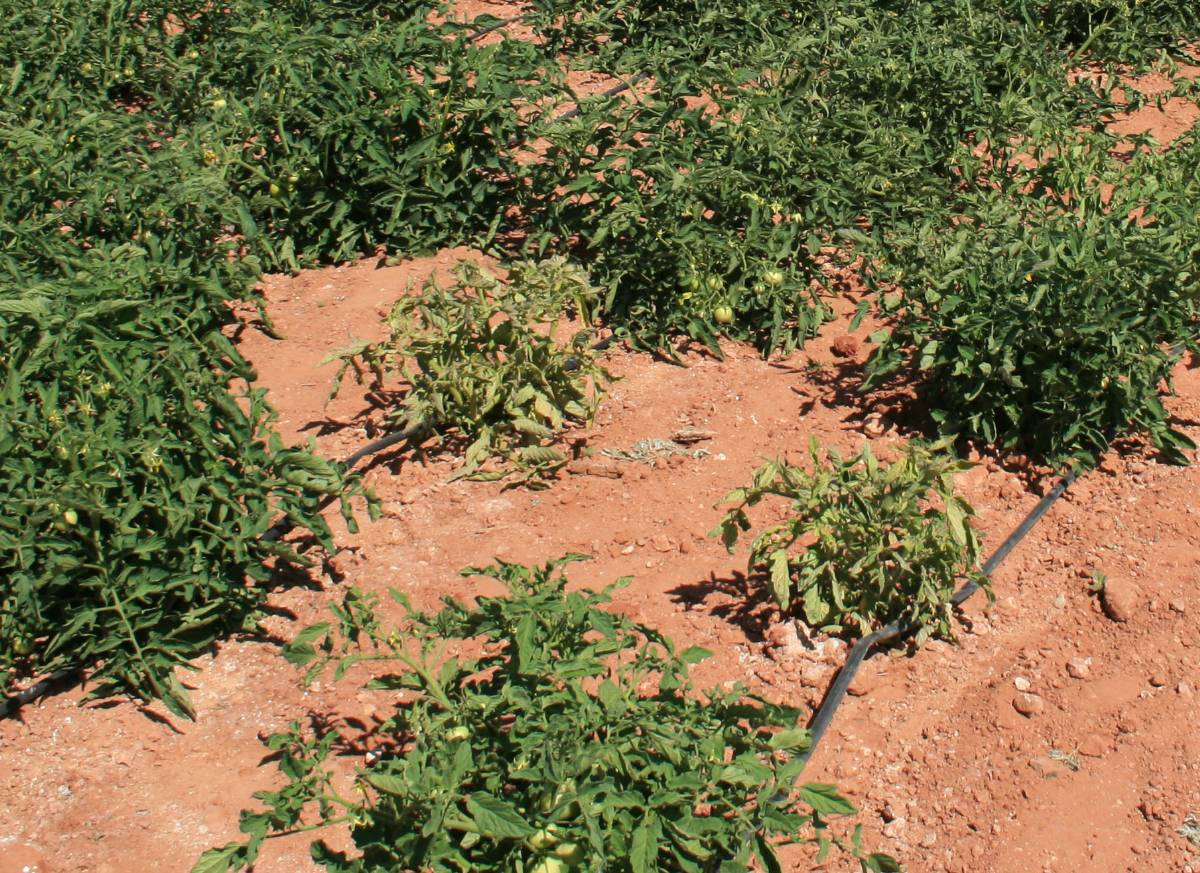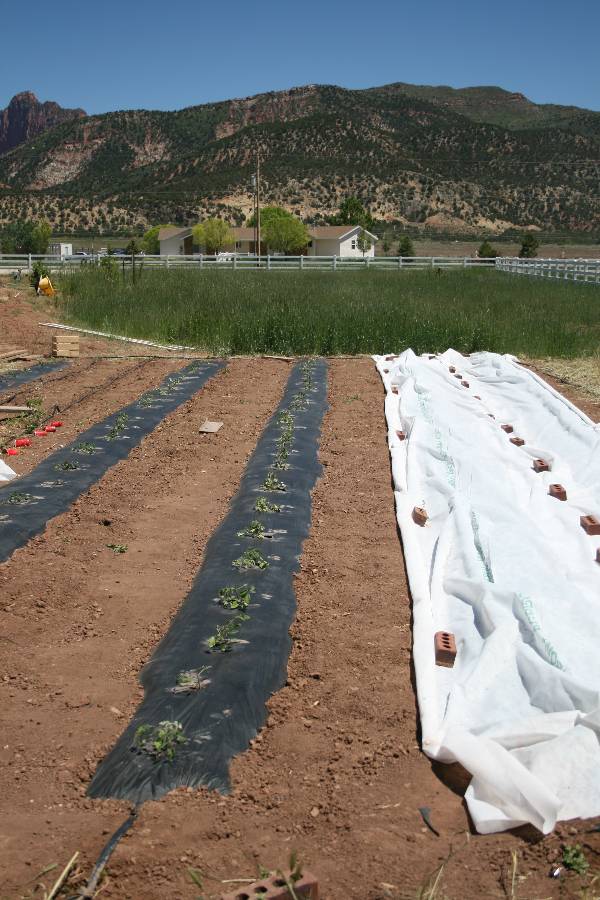Journal of the NACAA
ISSN 2158-9429
Volume 5, Issue 2 - December, 2012
Controlling Curly Top of Tomato Using Resistant Varieties and Row Covers
- Heflebower, R., Horticulture Agent, Utah State University Extension
Reid, C., Agriculture Agent, Utah State University Extension
Winward, D., Associate Professor, Southern Utah University
ABSTRACT
Curly top is a virus which causes wilting and death of tomatoes and other vegetables. Tomato plant losses have been reported as high as 90% in southern Utah. Curly top virus (CTV) is an insect vectored virus that is thought to be transmitted by the beet leafhopper (BLH, Circulifer tenellus). In 2009 the varieties Columbian and Rowpac, reported to be curly top resistant, were selected to compare with other popular varieties Celebrity, Jet Star, and Mountain Fresh . The resistant varieties, Columbian, and Rowpac showed 5.5% and 11.1% infection, compared to Celebrity, Jet Star and Mountain Fresh showing 22.2%, 5.5%, and 16.6% infection respectively. Any resistance present in the varieties tested must be very weak since both "resistant" and "hybrid" varieties showed CTV symptoms. In a separate study in 2010, row covers were applied to half of the plants as a way to exclude leafhopper feeding. BLH activity was monitored both inside and outside the covers using yellow sticky traps. There were six times more BLHs outside the row covers than there were inside the covers. None of the covered plants showed CTV symptoms and five of the control plants were symptomatic. Row covers appear to be an effective way to prevent CTV.
CURLY TOP RESISTANT TOMATO VARIETIES
Introduction
Curly top virus (CTV) affects a wide range of plants in semi-arid areas of the western United States. Commercial vegetable fields have reported sporadic losses in all of the southwestern states including California, Nevada, Utah and Arizona. Crops affected by CTV include beets, tomatoes, Swiss chard, spinach, beans, and cucurbits such as squash, cucumbers and watermelon. Serious problems have been reported in “staked tomatoes” grown for fresh market, with plant losses as high as 90% in some years. CTV is transmitted by the beet leafhopper (BLH, Circulifer tenellus). The BLH overwinters in host plants such as Kochia, Lambsquarter, Halogeton, Russian thistle (Tumbleweed), Greasewood, and Four-winged Saltbrush. As range plants begin to dry out in late spring and early summer, BLH will begin to feed on horticultural plants. BLH has a piercing-sucking feeding habit and is known to transmit the virus from infected to healthy plants. If fruit is present, it will usually remain small and turn red without developing full flavor. Sometimes affected and normal fruits will appear on the same plant. Once infected with the virus, plants will not recover but remain stunted without setting additional fruit. This study focuses on the use of disease resistant tomato varieties and row covers as possible control methods.

Figure 1. Field - The two plants in the center of this field are infected with CTV.
Methods
Prior to planting, black plastic was laid with drip irrigation line under the plastic. All tomato plants were spaced three feet apart in the row with four feet between rows. The following open pollinated tomato cultivars were developed by Washington State University and characterized as resistant to CTV; Roza, Saladmaster, Columbian, and Rowpac (Johnson and Martin). During the 2008 growing season, all four varieties were planted and observed by Extension Agents and Master Gardeners in Washington and Iron Counties located in southwest Utah. Columbian, and Rowpac were selected to compare with other varieties because of their superior size, and performance. Other tomato varieties chosen to compare to Columbian and Rowpac in 2009 included; Celebrity, Jet Star, and Mountain Fresh. Six plants of each of the five varieties were planted in a randomized design and replicated three times (total of 90 plants). Plants were evaluated for CTV symptoms weekly.
In a separate study conducted in 2010, 40 Celebrity tomato plants were planted in four replications for a total of 160 plants. The soil was prepared using black plastic and drip line as in the earlier study. The same plant spacing was also followed. One half of the plants (80) were treated with row covers to exclude BLH feeding and the other half were left uncovered (control). Row covers were applied the same day tomatoes were transplanted to exclude BLH feeding. Covers were left in place for four weeks and then removed. About four weeks after planting, tomato plants are large enough to begin pushing the covers off, making it more difficult to keep them completely covered. This is also about the time that tomato plants begin to flower. Although tomatoes are wind pollinated, the covers may decrease pollination if left in place when fruit set begins. Yellow sticky cards (3.5 x 5 in.) were used to monitor BLH activity. One card was placed next to an uncovered row. A second card was placed next to a row in the covered section (underneath the row cover).

Figure 2. Tomato plantings - half treated with row covers.
Results
In the 2009 study, five tomato varieties were evaluated for CTV. All varieties including those reported to be CTV resistant had from 1-4 plants infected. The variety Celebrity had four infected plants (22.2%%), followed by Mountain Fresh with three infected plants (16.6%), then Rowpac with two infected plants (11.1%) and Columbian and Jet Star each had one infected plant (5.5%) (See Table 1).
| Variety |
# Symptomatic |
# Healthy |
Total in |
% Plants |
| Rowpac | 2 | 16 | 18 | 11.1% |
| Columbian | 1 | 17 | 18 | 5.5% |
| Celebrity | 4 | 14 | 18 | 22.2% |
| Jet Star | 1 | 17 | 18 | 5.5% |
| Mountain Fresh | 3 | 15 | 18 | 16.6% |
Table 1. Results of 2009 CTV resistance study.
In the 2010 study, five plants in the uncovered (control) portion were infected with CTV. None of the covered plants showed any symtoms of CTV infection (See Table 2). Yellow sticky cards inside the row covers contained 20 BLHs, compared to 120 found on the cards outside of the covers.
| Treatments |
# Symptomatic Plants |
# Healthy Plants |
Total in Treatment |
% Plants |
| Uncovered | 5 | 75 | 80 | 6.2% |
| Covered | 0 | 80 | 80 | 0 |
Table 2. Results of 2010 row cover study.
Discussion
The goal of both fresh market growers and home growers is to produce a high quality tomato with good size, color and flavor. Tomato production in the southwestern United States is severely limited some years due to CTV. The cultivars Columbian and Rowpac, which had been reported to be resistant to CTV, showed little if any more resistance than the three popular hybrid varieties Celebrity, Jet Star and Mountain Fresh they were compared to in 2009. Roza and Saladmaster varieties also reported to be resistant to CTV were observed to have severe symptoms in 2008. There does not appear to be sufficient resistance in the varieties used in this study to prevent infection.
Row covers have been used for many years in vegetable production primarily to increase earliness and yield. They have also been used to prevent feeding damage from insects such as whitefly (Natwick and Durazo). The study conducted in 2010 showed row covers to be an effective means of reducing feeding damage to tomato plants. The numbers of leafhoppers found on sticky traps outside the covers were six times the amount found inside. Lowering feeding pressure by using row covers appears to have also lessened the amount of CTV infection. When row covers are used, it is important that they be applied immediately after transplants are set in the field. It is also important that young transplants not be exposed to potential BLH feeding while being grown, relocated or while waiting to be transplanted. Once covers are applied, they should be weighted down so they are not blown off by the wind. Securing the fabric at the ends of each row and keeping the edges tight to the ground will help prevent hoppers from gaining access to plants.
Literature Cited
Damicone, J., & Brandenberger L. (n.d.). Common diseases of tomato, part 2 diseases caused by bacteria, viruses and nematodes. Online. Oklahoma Cooperative Extension Service. http://pods.dasnr.okstate.edu/docushare/dsweb/Get/Document-1327/EPP-7626web.pdf
Heflebower, R., Reid, R., Frank, E., & Evans, K. (2008). Curly top of tomato. Online. Utah State University Extension and Utah Plant Pest Diagnostic Lab. http://utahpests.usu.edu/IPM/files/uploads/Advisories-Veg/Curly%20Top%20Tomato/curly-top-tomatos08.pdf
Johnson, D.A., & Martin M. (n.d.). Curly top of tomato. Online. Washington State University. http://cru.cahe.wsu.edu/CEPublications/eb1255/eb1255.html
Natwick, E., & Durazo III, A. (1985). Polyester covers protect vegetables from whiteflies and virus disease. Online. California Agriculture. http://ucce.ucdavis.edu/files/repositoryfiles/ca3907p21-62879.pdf
Thompson, S., & Ockey, S. (n.d.). Curly top of tomato. Online. Utah State University Extension. http://utahpests.usu.edu/plantdiseases/htm/vegetable/curlytop
